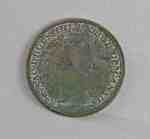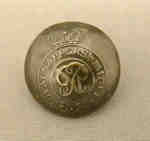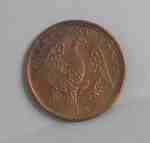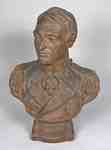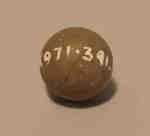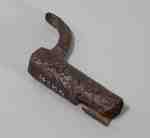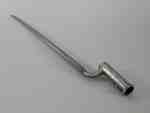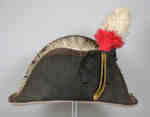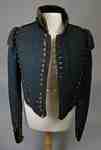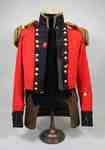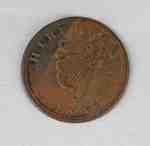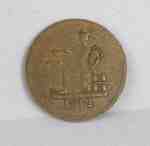Results
- This button likely belonged to a member of the Royal Sappers and Miners. The button was produced by button maker, McGowan of London. The button was dug up at Fort George.This button likely belonged to a member of the Royal Sappers and …
- This button has a relief crown and field gun facing proper right. It is believed to be from the Royal Artillery and measures 2 cm in diameter.This button has a relief crown and field gun facing proper right. …
- A half-penny coin featuring an eagle on one side and liberty on the other. The Eagle Half Penny Tokens were struck over original 'Samuel Guppy' Tokens from Bristol England. A Boston Merchant Named NyA half-penny coin featuring an eagle on one side and liberty on …
- A terra cotta bust of Sir Isaac Brock in a uniform with lettering at the base.A terra cotta bust of Sir Isaac Brock in a uniform with …
- This musket, circa 1812, is a 3rd Model “Brown Bess” 1790 with an “India Pattern” design. It was a British regulation issue flintlock musket. There are various engravings on the musket that include:This musket, circa 1812, is a 3rd Model “Brown Bess” 1790 with …
- This bayonet is of an officer’s fusil musket design. It has a triangular blade and is date circa 1812. A bayonet is a steel blade that is designed to fit on the muzzle of a rifle or musket barrel, maThis bayonet is of an officer’s fusil musket design. It has a …
- This cotton flag features a colonial Union Jack design and a stamp that reads "War of 1812". Although the flag is hand-stitched, it is not clear whether the flag was used during the War of 1812 or noThis cotton flag features a colonial Union Jack design and a stamp …
- Original donated and identified as a clay musket ball with a circumference of 5cm. It is highly doubtful that such an item would ever be used effectively as a musket ball and is more likely a marbleOriginal donated and identified as a clay musket ball with a circumference …
- This is a bayonet socket with a small portion of the blade attached that was discovered in the Niagara River. A bayonet is a steel blade that is designed to fit on the muzzle of a rifle or musket barThis is a bayonet socket with a small portion of the blade …
- This triangular bayonet is dated circa 1812 and has the distinctive markings “S. Chambers” and “46 (Crown)” on the blade. A bayonet was designed to fit on the muzzle of a rifle or musket barrel, makiThis triangular bayonet is dated circa 1812 and has the distinctive markings …
- This Winchester sword has a steel blade and a leather scooped handle with twined leather.This Winchester sword has a steel blade and a leather scooped handle …
- This sword is believed to be from an American soldier in the artillery. It is decorated with an embossed gilded pattern of an American eagle crest and floral motifs. The hilt also has an eagle head pThis sword is believed to be from an American soldier in the …
- This is a black beaver felt hat with an ostrich feather, brass braids and bullion at its peaks. It also has a linen band trim, a black cockade and a double brass coin chain that run to buttons on theThis is a black beaver felt hat with an ostrich feather, brass …
- This is a wool and velvet coatee that is believed to be designed for a Glengarry Militia Officer, but the date of origin is unknown. It is a single breasted green coat with a velvet trimmed stand upThis is a wool and velvet coatee that is believed to be …
- This uniform coat belonged to Colonel Aeneas Shaw of the 1st Regiment of the Lincoln Militia during the War of 1812. It is believed to be a staff officer uniform and has five pairs of buttons down thThis uniform coat belonged to Colonel Aeneas Shaw of the 1st Regiment …
- This copper coin features Field Marshall Wellington on one side and an Irish harp on the other. This coin dates to 1805 and is a good example of currency from the 1812 period.This copper coin features Field Marshall Wellington on one side and an …
- This half penny coin dates from 1812 and depicts Liberty on the front side. On the reverse is the portrait of King George III and a Laurel Wreath. and is the type of currency that would have been useThis half penny coin dates from 1812 and depicts Liberty on the …
- This copper coin features a laurel wreath with an etching of George III. This is an example of what currency looked like at the time of the War of 1812.This copper coin features a laurel wreath with an etching of George …
- This plume with black feathers and a wooden base would have been placed on a soldier’s shako. It is believed to have belonged to Captain Martin McLellan who took part in the battle of Queenston HeighThis plume with black feathers and a wooden base would have been …





